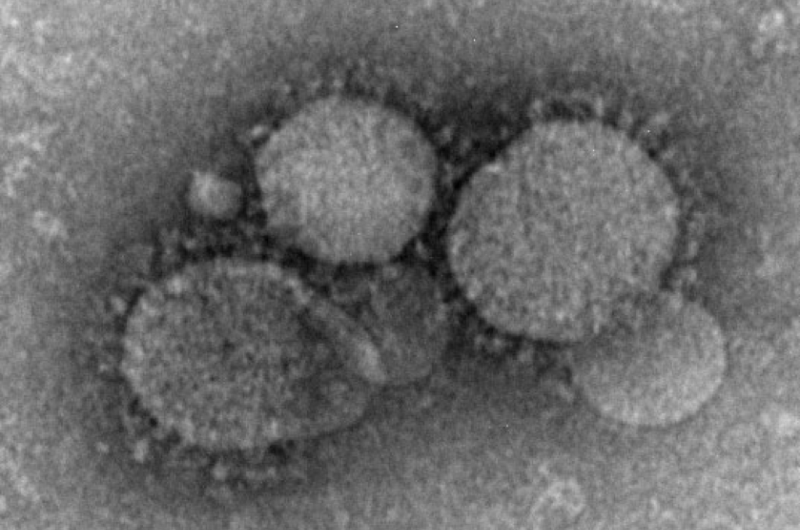Bat virus receptor studies vital to predict spillover risk

New research shows that the closest bat virus relatives of the human Middle-East Respiratory Syndrome (MERS) coronavirus efficiently bind to bat ACE2 receptors as an entry point into these cells. These receptors have some similarities to the ACE2 receptors in human cells.
However, at present this coronavirus, called NeoCoV and a similar virus, PDF-2180, only weakly bind to human ACE2 cell receptors as an entry point into cells. They also are not known to cause disease outbreaks in people.
"To date," the scientists reporting this latest research noted, "there is no evidence that NeoCoV and PDF-2180 can infect any mammals other than bats.
Strikingly, MERS coronavirus, like a few other related, well-characterized merbecoviruses utilizes a completely different cell receptor called DPP4 (dipeptidyl peptidase-4).
Human ACE2, an angiotensin-converting enzyme receptor, is the major cell entry receptor for infections in people with SARS-CoV-2, the coronavirus that causes COVID-19. It is also the human cell receptor for SARS-CoV-1, the cause of Severe Acute Respiratory Syndrome, identified in 2003 after a pneumonia outbreak later confirmed to have jumped across species.
Overall, many other sarbecoviruses, an alphacoronavirus (setracovirus), and a group of merbecoviruses share the ability to bind to ACE2 in the cells of certain animals. The convergent evolution that led widely different coronaviruses to use ACE2 as entry receptors remains unclear.
Cryo-electron microscopy analysis revealed that NeoCoV has a distinct way of binding with the bat ACE2 receptor, compared to the other coronaviruses known to use that receptor.
The findings of this research, conducted by an international team of scientists, appear in the Dec. 7 edition of Nature. The senior and corresponding authors of the paper are David Veesler, associate professor of biochemistry at the University of Washington School of Medicine in Seattle and an investigator of the Howard Hughes Medical Institute; Xiangxi Wang of the Institute of Biophysics at the Chinese Academy of Sciences in Beijing, and Huan Yan of the College of Life Sciences at Wuhan University.
Discovering that ACE2 is the host cell receptor for NeoCoV and PDF-2180, which are closely related to the deadly human pathogen MERS-CoV, was totally unexpected and opens new avenues to prepare for the possible future zoonotic transmission of these viruses, according to the researchers on this study. This information is critical in setting up a watch-list of families of animal viruses that present a risk of emerging as zoonotic diseases in people.
The lack of knowledge about which cell receptors bat coronaviruses use, the researchers explained, limits scientific understanding of their cell entry strategies and of the virus' propensity for interspecies transmission.
Observing the complexities of how coronaviruses use cell receptors, the researchers noted in their paper, highlights the importance of additional research and surveillance on these viruses to stay ahead and be prepared for future outbreaks.
The researchers on this current study also sought to gather data that might provide clues to the origin of MERS-CoV. Their results support earlier hypotheses that MERS-CoV may have appeared after a recombination event between a virus that was like NeoCoV and a virus that preferred the DPP4 cell receptor.
While the history of this event has not been confirmed, the scientists surmised that such genetic recombination in viruses can happen when a host animal is co-infected with different coronaviruses. In this way a new coronavirus can emerge, using a distinct cell receptor with possible expansion of host range.
For MERS-CoV, the scientists noted that it remains uncertain whether such an event could have occurred in bats, camels, or other animals, or when the switch to a new animal (or human) host could have taken place.
The two viruses, NeoCoV and PDF-2180, prefer the ACE2 cell receptors in vesper bats, part of the species Vespertilionidae. Most merbecoviruses are found in that species. This is a remarkably diverse, widely dispersed bat species.
While NeoCoV does not have a strong affinity for the ACE2 receptor on human cells, the scientists pointed out NeoCoV could undergo adaptive changes that would allow it to enter human cells more readily. The extensive mutations in the key cell binding regions of the COVID-19 virus (SARS-CoV-2), particularly in the Omicron variant, indicate that other coronaviruses may hold the still unrealized ability to adapt through mutations.
On the other hand, spillover of viruses from one animal species to another is a complicated transition that involves not just recognizing a cell receptor in the jumped-to species, but also subverting host immune responses, contact opportunity, conditions suitable for the virus to replicate, and many other factors.
The researchers also mentioned that MERS-CoV antibodies and antibodies generated by current COVID-19 vaccinations do not adequately neutralize NeoCoV and PDF 2180. However, their results showed that broadly neutralizing antibodies that target evolutionarily conserved regions of NeoCoV and PDF-2180 do inhibit the entry of these viruses into cell. They suggest that these broader-acting antibodies should be considered for preparedness against spillover to humans by these viruses.
More information: Huan Yan, Close relatives of MERS-CoV in bats use ACE2 as their functional receptors, Nature (2022). DOI: 10.1038/s41586-022-05513-3. www.nature.com/articles/s41586-022-05513-3
Journal information: Nature
Provided by University of Washington School of Medicine





















